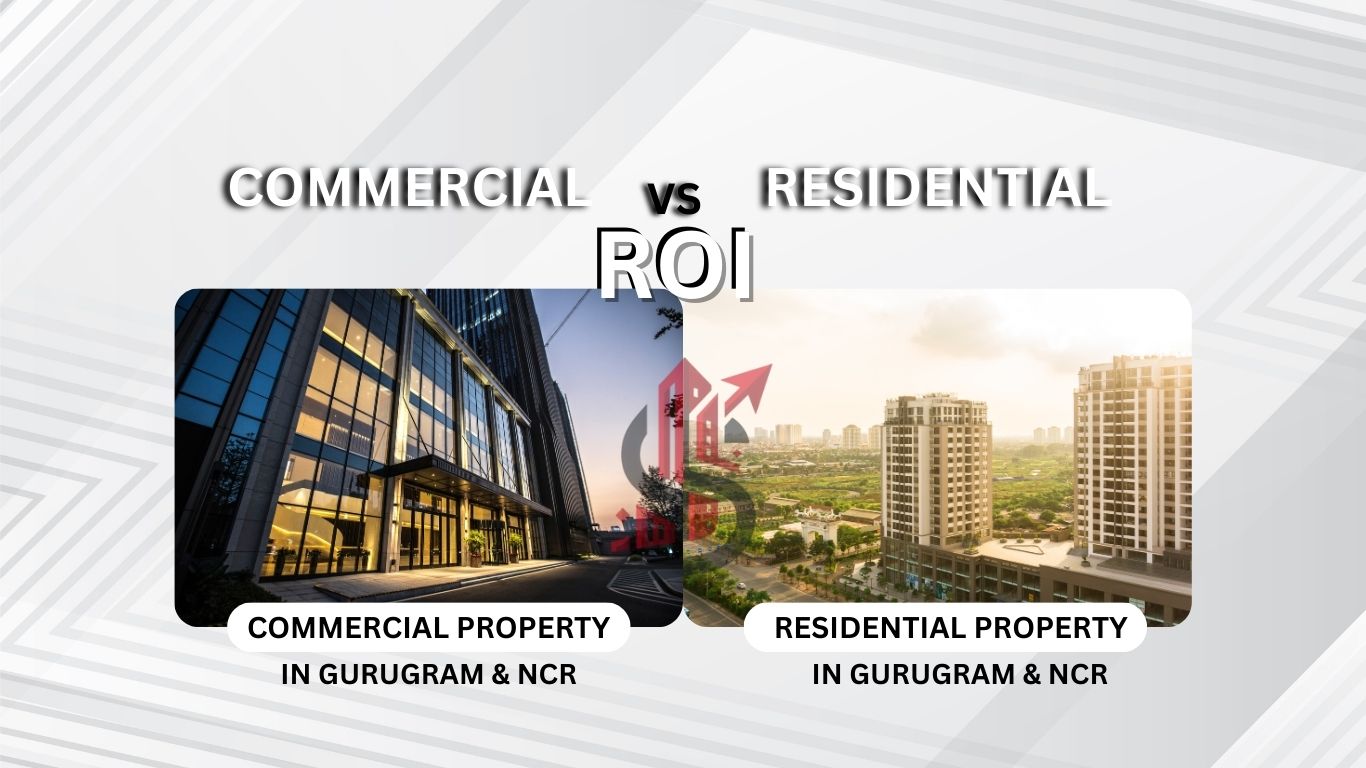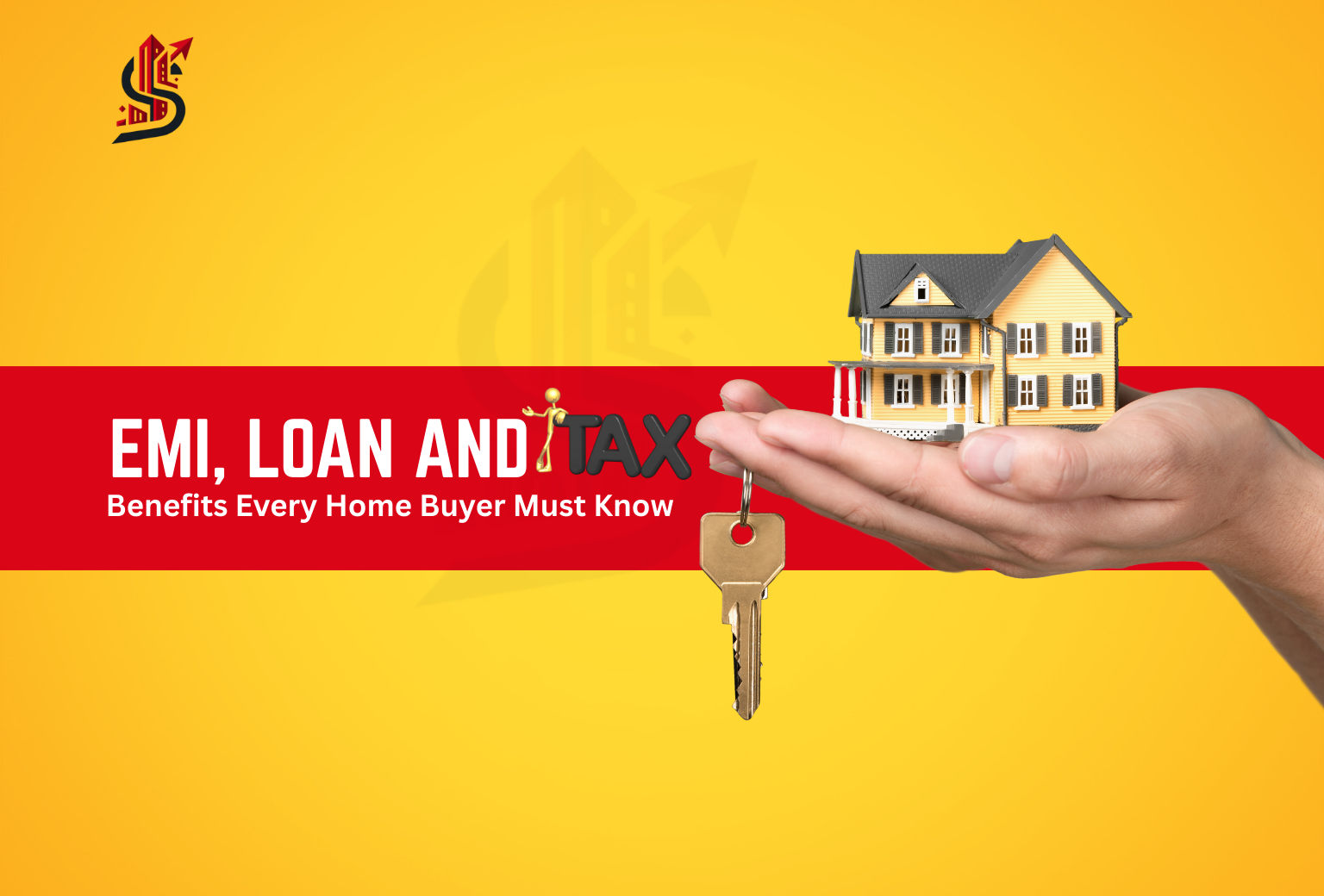The Changing Landscape of Real Estate Investments
Real estate has always been seen as a reliable investment choice for individuals and institutions. Traditionally, residential properties like apartments, villas, and single-family homes have made up the majority of investor portfolios, especially for first-time buyers. However, over the last decade, more investors have shifted their focus to commercial real estate, including office spaces, retail stores, co-working facilities, and industrial properties.
The reason for this shift is clear. Returns on commercial property investments often exceed those of residential investments by a significant margin. A residential property might generate a rental yield of 2 to 3% each year, while commercial real estate can offer returns ranging from 6 to 12%, depending on factors like location, property type, and tenant profile.
This difference in return on investment (ROI) has prompted both individual and institutional investors to consider commercial property as a viable opportunity for building wealth. In markets like Gurugram, where corporate growth, infrastructure development, and global business presence intersect, commercial property investors find unparalleled opportunities.
But why does commercial property yield better returns compared to residential? More importantly, how does a trusted Real Estate Investment Adviser like Sribha Realtech help investors maximize their gains while reducing risks?
This article delves into the topic by examining both educational aspects—ROI, risk-reward balance, market dynamics—as well as promotional elements—how Sribha Realtech acts as the best property investor adviser for navigating the complex yet rewarding world of commercial real estate.
Understanding ROI in Real Estate: Commercial vs. Residential
When evaluating real estate investments, ROI (Return on Investment) is the most important metric. It shows investors the annual income the property can generate compared to its cost. It also indicates the long-term growth potential of the asset.
Let’s break down ROI for residential and commercial properties:
1. Residential Property ROI
- Rental Yield: 2 to 3% on average each year in Indian metros.
- Capital Appreciation: Strongly depends on location, demand, and urban development. This is usually long-term.
- Tenant Profile: Families or individuals, with shorter rental cycles; 11-month agreements are common.
- Risks: High vacancy rates, delayed rental payments, and limited increase clauses in agreements.
2. Commercial Property ROI
- Rental Yield: 6 to 12% annually, which is much higher than residential.
- Capital Appreciation: Steady growth because of demand from corporations, retail chains, and startups.
- Tenant Profile: Businesses, MNCs, and co-working brands; leases typically last 3 to 9 years.
- Stability: Lease agreements often include lock-in periods and increase clauses for annual rent.
Example:
If you buy a ₹1 crore residential apartment in Gurugram, you might earn ₹20,000 to ₹25,000 per month in rent. In contrast, a ₹1 crore commercial office space could yield ₹60,000 to ₹90,000 per month, which is three times the rental income, with longer and more stable lease commitments.
This key difference in ROI makes commercial real estate a preferred choice for serious investors wanting to maximize returns and diversify their portfolios.
Why Investing in Commercial Property Can Give Higher Returns Than Residential
Real estate has long been one of the most reliable and rewarding investment options for Indians. However, the market dynamics are changing quickly. In the past, investors focused mainly on residential properties like apartments, villas, and independent houses. Recently, attention has shifted significantly toward commercial real estate in Gurugram and the wider NCR region (Delhi-NCR).
The reasons for this shift are clear. Gurugram, known as the Millennium City of India, has turned into a global business hub. It hosts Fortune 500 companies, IT giants, co-working brands, and high-end retail spaces. With its modern infrastructure, metro connectivity, and closeness to the international airport, Gurugram has become the center for commercial real estate investment in India. The entire NCR, which includes Noida, Faridabad, and parts of Delhi, has seen similar trends, attracting both institutional and individual investors.
What stands out in this shift is the difference in return on investment (ROI). A residential property in Gurugram or NCR might yield a modest rental return of 2 to 3% annually. In contrast, a commercial office space or retail outlet in the same area can offer returns of 6 to 12%, often based on stable corporate tenants. This significant difference has made commercial property in Gurugram and NCR one of the most profitable investment options in India today.
As investors become more aware of the benefits of commercial assets, the role of a trusted real estate investment adviser like Sribha Realtech becomes essential. Sribha not only helps investors choose the right projects but also ensures their investments are supported by market insights, corporate leasing knowledge, and long-term growth plans.
Understanding ROI in Real Estate: Gurugram/NCR – Commercial vs. Residential
When evaluating any real estate investment, ROI is the first and most important measure of profitability. Gurugram and NCR provide a great example of how commercial real estate performs better than residential in almost every aspect.
1. Residential Property ROI (Gurugram/NCR)
- Rental Yield: On average, 2 to 3% annually. For instance, a ₹1 crore apartment in Gurugram might earn only ₹20,000 to ₹25,000 per month in rent.
- Capital Appreciation: Strong in luxury and ready-to-move apartments, but highly dependent on location and the balance of supply and demand.
- Tenant Profile: Individuals or families; shorter rental agreements, typically lasting 11 months.
- Risks: Higher vacancy rates, inconsistent rental income, and fewer opportunities for rent increases.
2. Commercial Property ROI (Gurugram/NCR)
- Rental Yield: 6 to 12% annually. A ₹1 crore commercial office space in Gurugram can earn ₹60,000 to ₹90,000 per month, which is three times higher than residential rental income.
- Capital Appreciation: Strong due to ongoing corporate expansion and high demand for Grade-A office spaces and retail hubs.
- Tenant Profile: MNCs, startups, co-working operators, and retail chains; lease tenures generally range from 3 to 9 years.
- Stability: Commercial leases often include lock-in periods of 3 to 5 years and annual rent increase clauses, which help ensure steady income growth.
This makes Gurugram and NCR not only the geographical center of India’s corporate growth but also an attractive place for high ROI real estate investments.
Why Commercial Property in Gurugram & NCR Outperforms Residential Investments
The real estate market in Gurugram and NCR is a living example of how commercial properties consistently deliver stronger and more predictable returns than residential assets. Investors who once favored apartments and villas are now strategically moving toward office spaces, co-working hubs, retail outlets, and commercial plots, as they recognize the long-term financial advantages.
Here are the top factors that explain this shift:
1. Higher Rental Yields
Rental yield is the most visible difference between commercial and residential property.
- Residential Properties in Gurugram/NCR: Average yields of 2–3%. For instance, a luxury ready-to-move apartment worth ₹1.5 crore might fetch just ₹35,000–40,000 per month.
- Commercial Properties in Gurugram/NCR: Rental yields range from 6–12%. A premium commercial office in Cyber City or Golf Course Extension Road worth ₹1.5 crore can generate ₹1–1.2 lakh per month in rent.
👉 This 3x difference in income makes commercial properties far more lucrative for investors seeking consistent cash flow and high ROI.
2. Longer Lease Tenures & Stability
Residential tenants usually sign 11-month agreements and can leave with short notice, creating income uncertainty.
On the other hand, commercial tenants—corporates, startups, co-working operators, and retail chains—sign leases of 3–9 years with lock-in periods. This ensures:
- Steady income streams for the investor
- Reduced vacancy risks
- Predictable long-term returns
In Gurugram, many MNCs and IT companies prefer long leases in hubs like Cyber Hub, Udyog Vihar, and Golf Course Road, giving investors financial stability unmatched in the residential market.
3. Corporate & Premium Tenant Profiles
Residential properties often depend on individuals or families, who may face financial instability or job transfers.
Commercial properties in Gurugram attract high-profile tenants such as:
- Fortune 500 companies
- Global IT firms
- Co-working giants (WeWork, Smartworks, Awfis)
- Retail chains & luxury brands
👉 These tenants not only offer financial credibility, but also sign escalating rental agreements, which increase investor income year-on-year.
4. Annual Rent Escalation Clauses
Residential rents in Gurugram and NCR increase modestly, usually by 5–7% annually or at the time of renewal.
Commercial lease agreements, however, often include fixed escalation clauses of 10–15% every 3 years. This means:
- Investor income grows automatically
- Long-term ROI remains inflation-proof
- Asset value rises due to higher rental yields
For example, a ₹1 crore office space leased at ₹70,000/month today could generate over ₹90,000/month within 5 years due to escalation clauses.
5. Capital Appreciation Potential
While both residential and commercial properties appreciate in value, commercial real estate in prime Gurugram/NCR locations has seen faster appreciation rates in recent years.
- Commercial hubs like Golf Course Extension, MG Road, Dwarka Expressway, and Cyber City have witnessed a 20–30% appreciation in office and retail space values in just 3–5 years.
- The demand for Grade-A office spaces remains high due to the influx of MNCs and startups, pushing both rental and resale values upward.
6. Rising Demand for Commercial Spaces in Gurugram
The NCR region, particularly Gurugram, is witnessing:
- Expansion of IT/ITES sector and co-working culture
- Booming retail sector with premium malls and high-street outlets
- Global corporations relocating headquarters from Delhi to Gurugram
This ensures that demand for commercial spaces is sustainable and future-proof, offering investors a robust growth pipeline.
7. Technology-Driven Growth
Commercial real estate in Gurugram is also benefitting from real estate technology (PropTech), such as:
- Smart buildings with IoT integration
- AI-driven energy efficiency solutions
- Online property management platforms
This adoption of technology increases asset desirability for corporate tenants, thereby strengthening investor returns.
Gurugram – India’s Commercial Investment Hub
When discussing high-return commercial real estate investments in India, Gurugram (Gurgaon) and the larger NCR region immediately stand out. Once a satellite town, Gurugram has transformed into a global business hub, attracting multinational corporations, startups, and high-net-worth investors.
1. Gurugram’s Position as India’s Corporate Nucleus
Gurugram is home to:
- Over 250 Fortune 500 companies
- India headquarters of global giants like Google, Microsoft, Deloitte, KPMG, and Accenture
- IT, finance, consulting, and automobile companies spread across Cyber City, Udyog Vihar, and Golf Course Extension
👉 This corporate presence creates massive demand for Grade-A office spaces, retail outlets, and commercial complexes—a demand that far outpaces residential rentals in terms of profitability.
2. ROI Comparisons – Commercial vs. Residential in Gurugram
Here’s a snapshot of how returns vary between commercial and residential assets in the city:
| Asset Type | Average Investment Size | Rental Yield (%) | Lease Tenure | Annual Rent Escalation |
| Residential Apartment | ₹1–2 Crore | 2–3% | 11 months–2 years | 5–7% on renewal |
| Commercial Office Space | ₹1.5–3 Crore | 7–10% | 3–9 years | 10–15% every 3 years |
| Retail High-Street Shop | ₹50 Lakhs–2 Crore | 9–12% | 5–10 years | 12–15% every 3 years |
| Co-working / Shared Space | ₹80 Lakhs–3 Crore | 8–11% | 3–6 years | 10–12% every 3 years |
👉 Clearly, commercial assets in Gurugram generate 3–4x higher yields than residential ones while also ensuring longer stability.
3. Success Story: DLF Cyber City & Golf Course Road
- DLF Cyber City: Known as India’s “Wall Street,” Cyber City’s office spaces boast 95% occupancy rates with rental yields of 8–10%. Investors who bought office floors here a decade ago have seen capital values triple, along with steadily rising rental income.
- Golf Course Road & Extension: Retail outlets and office towers here command premium rents from MNCs, co-working operators, and luxury retail brands. An investor purchasing a shop for ₹1 crore five years ago could now expect both capital appreciation of 40–60% and stable rental income of ₹80,000–₹1 lakh/month.
4. Why Global Investors Choose Gurugram
The surge in foreign direct investment (FDI) in Indian real estate has heavily favored Gurugram. Key reasons include:
- Proximity to Delhi & IGI Airport – making it a global business destination
- World-class infrastructure – expressways, metro connectivity, luxury malls, IT parks
- Favorable state policies – Haryana’s pro-business stance attracts corporate occupiers
- Consistent demand – rising startups, fintech firms, and Fortune 500 companies expand office requirements
For example, Blackstone, Brookfield, and GIC have invested billions in Gurugram’s commercial properties, signaling global confidence in the market.
5. The Co-Working & Startup Culture Boom
India’s startup ecosystem is centered in Gurugram, which houses thousands of small and mid-sized companies. This has fueled demand for:
- Flexible office spaces
- Shared workspaces and incubation hubs
- Affordable, scalable commercial units
Companies like WeWork, Awfis, Smartworks, and Innov8 are aggressively expanding in Gurugram, ensuring investors in co-working-focused assets enjoy high occupancy rates and reliable cash flows.
6. Retail & High-Street Investment Growth
Apart from offices, retail real estate in Gurugram is thriving. High-street outlets in areas like MG Road, Sector 29, and Sohna Road see constant footfall from urban professionals and residents.
- Popular global chains (Starbucks, H&M, Zara, McDonald’s) prefer lease-based models, providing investors stable long-term rental income.
- With the rise of luxury shopping and entertainment culture, retail yields of 10–12% are common.
7. Government & Infrastructure Push
Projects like:
- Dwarka Expressway
- Delhi-Mumbai Industrial Corridor (DMIC)
- Rapid Metro
are further cementing Gurugram’s position as India’s most lucrative commercial real estate hotspot. Infrastructure boosts not only increase property values but also create endless tenant demand.


